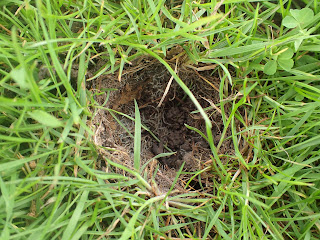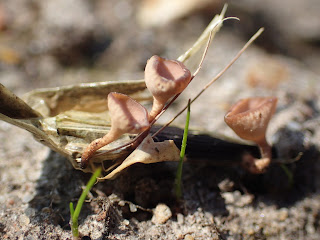Having been busy for the first two dates, Saturday was my first fungus study group foray of the year. Ian was busy with the flora group, so I headed straight to Mannington Hall and met another ten or so members of the group in the main car park. There was a range of habitats to explore, and first up were the main hall grounds. Spring forays tend to be dominated by species that occur all year round like plant fungi and things on wood, but there are a few spring specialists. One of these is Cedar Cup (Geopora sumneriana). This species is common in some parts of the country but I'd never seen it, so I was particularly pleased to find one under the second Cedar I checked. Another 20 or so fruiting bodies were then found under the same tree, but it was also evident that some had been removed, presumably eaten by a Grey Squirrel or Muntjac, which might partly explain why I'd not come across them before.
A few more species were added in the grounds, including Rhododendron Bud Blast, which looks spectacular in closeup, and Snowy Disco, which likewise is tiny but interesting with its furry white discs. Two agaric-types were also seen, Wood Blewit and Parasola schroeteri.
Leaving the grounds we headed into some dry woodland, which as expected wasn't particularly productive. I did find Bleeding Broadleaf Crust on a Hazel branch, and we also recorded the unremarkable leaf fungus Cercospora mercurialis on Dog's Mercury, the rust Puccinia sessilis on Cuckoo Pint and marvelled at the large expanse of Opposite-leaved Golden Saxifrage.
In the woods themselves we saw a few other bits and bobs, but nothing to write home about. I was becoming frustrated by some very flitty micro moths that refused to land, but in some sort of invertebrate karma one flew into a spiders web nearby and I confirmed that it was a Common Oak Purple, Dyseriocrania subpurpurella.
Back onto the road we walked down to the stream and into a wetter area of woods. It was fairly slow going here too, so after a bit of a look round we stopped for lunch in a clearing. After eating I had a quick wander around, seeing some Dark-edge Beeflies and Slender Groundhoppers.
Next stop was a sheep pasture nearby. A few of us walked through it, with some Banded Mottlegills being the only species of note. Looking back the rest of the group had barely moved, and this remained the case a while later. I began to suspect that the group had been infiltrated by some members of Dawdlers Anonymous on vacation, so headed back to see if they had found anything. There was a few bits and bobs, including the cup fungus Myriosclerotina curreyana and Nemania serpens on a branch, plus the tiny plant Blinks.
Finally leaving the field the next distraction was a ruined chapel, which we did a lap around. I found a tiny amount of Bluebell Rust before we left to return to the hall grounds. Walking past the lake we saw a Muntjac Deer and a Red Kite, before noticing that once again most of the group was missing. After a while we decided to move on to the wet meadow that we had been aiming for, only to find everyone else there too, having taken a different route via the cars.
Several of the group headed into the reeds, where they found several different cups and blobs on the dead stems, including two Mollisia spp. The sun was out, and looking for insects I found two hoverflies on Marsh Marigolds - Cheilosia pagana and Neoascia tenur. A Blue Shieldbug was hunting for Altica beetles, and a Vetch Piercer moth (Grapholita jungiella) was also seen. Before leaving I did a quick lap of the boardwalk, seeing a Smooth Newt in the small pond and hearing at least two Edible Frogs from the bird hide. The Red Kite then flew directly over my head, giving excellent views.
There was one more thing of interest, Yvonne had brought a Dotted Chestnut moth caught in Martham to show and get a second opinion on. It was the first time I had seen this species, which is scarce in Norfolk although spreading northwards.

















No comments:
Post a Comment